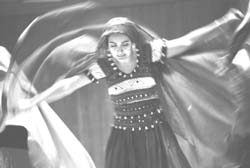|
News
|
|
|
Perspectives
|
|
|
Arts
|
|
|
Sports
|
|
|
Other
|
|

South Asian Culture Celebrated In Versatile Show
by Tim Willcutts

|
|
Swivel and Bop:
Several traditional South Asian dances will be performed tonight at 8 p.m in Warner Concert Hall.
|
The South Asian Student Association's third annual cultural show, being performed tonight at 8 p.m. in Warner concert hall, does not limit itself by genre or era. A modern composition by senior TIMARA major Raja Das shares the program with classical South Asian dances and a dramatic dialogue written by first-year Julie Dulani. "We like to cover all the ground," senior Master of Ceremonies Sabrina Rahman said, "Poetry, drama, music, and dance, both traditional and new."
The evening opened with sophomore Shruti Sasidharan performing a classical South Indian dance. Against a backdrop of flutes and lilting vocals she began, her legs pressed tightly together, then shook them loose, stomping fluidly across the stage. The piece alternated between near-stillness, during which Sasidharan's slight movements were highly disciplined and restrained, to sudden twirls.
An eight person ensemble shared the stage for a Rajasthan dance, set to upbeat pop and choreographed by sophomores Aneequa Kayani and Aneesha Idnani. Clad in blue, orange and green veils, skirts and blouses, the dancers filled Warner with the air of a gala, at one point locking hands with partners and spinning. Swirling skirts and slapping hands, they brought the evening's first half to a frolicsome close, finally collapsing in unison.
The evening's second half opened on a more meditative note, care of first-year Jay Gandhi's flute-playing and junior Mannesh Saini's hypnotic tabla backdrop. Gandhi's piece was by turns reticent, quietly stretching one note out over several seconds, and ecstatic, sputtering notes excitedly as if time were running out. The ultimate sense was of looseness, the meandering melody eluding any fixed pattern.
First year Shahana Siddiqui took the stage next for a Bangladeshi folk dance. Kneeling with one leg stretched straight, Siddiqui gradually lifted herself in swaying, pendulous motions to a standing position. Clad in a white gown, she turned every part of her body into a rhythmic device, right down to her fluttering fingertips.
Dulani's dialogue followed, juxtaposing her own commentary on growing up Asian in America, the exotification of Indian women and queer issues, with dramatic enactments of the topics. According to Dulani, the piece addressed, among other themes, "an inferiority complex, wanting to be white."
The evening closed with another eight person ensemble letting loose. Choreographed by junior Sonali Seth and sophomore Shruti Sasidharan, the dancers sat in a circle, rising gradually to the upbeat sound of "Chaiyya Chaiyya" ‹ taken from the popular film Dil Se. With much snapping of fingers and jovial hand slapping, the piece placed an implicit emphasis on community, made more explicit as the evening's performers joined them on stage, breaking into a boogie to cap off the night.
The show succeeded in melding various sensibilities, while maintaining a rich, focused peek at South Asian art and culture.
Copyright © 2000, The Oberlin Review.
Volume 129, Number 9, November 17, 2000
Contact us with your comments and suggestions.